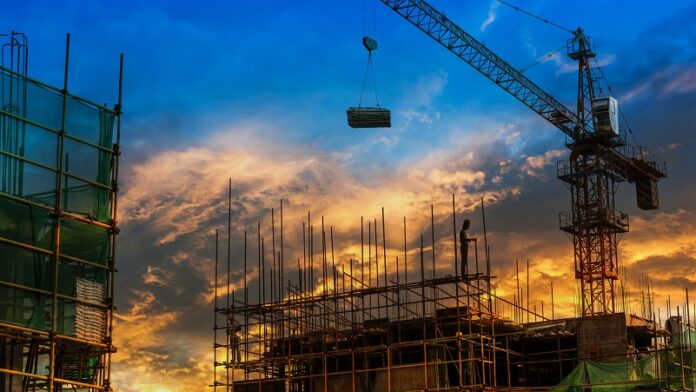Demand for cement, steel likely to surge as govt aims to revive construction activity
LAHORE: The demand for cement, steel, tiles, and other allied commodities is likely to increase as the federal government is aiming to revive the economic activities affected by the coronavirus pandemic through housing and construction sectors.
Also Read: Equity market gains 428 points on increased activity in construction
In this regard, the banks have been asked to allocate 5pc of their advance portfolio for the construction sector, while the government intends to provide Rs300,000 per unit subsidy to the first 100,000 units built under Naya Pakistan Housing Scheme. This will be conjoined by low rate financing of 5pc and 7pc for 5 and 10-marla houses, respectively.
According to Topline Securities, banks’ current exposure to the construction sector is 2pc of the overall credit to the private sector and 1pc of the overall advances.
“The government’s directive is expected to increase liquidity towards the construction sector by Rs300-350bn,” it predicted. “We expect further details from SBP on how this scheme will materialize; we take a cue from SBP’s earlier financing facility for Low-Cost Housing for Special Segments. The borrower rate for SBP refinance was 5pc, which included the bank’s spread of up to 4pc.”
Topline maintained the key risk for the banking sector remains implementation for foreclosure laws, as banks still remain reluctant to lend to the housing sector, even after the favorable decision by the Lahore High Court on this matter.
“Based on the back of envelope working, assuming 3pc spread, banks can earn an additional 3-5pc, unadjusted for risk,” Topline stated.
It estimated an additional cement demand of 1 million tonnes (2pc of overall sales) and a steel rebar demand of 150,000 tonnes (2-3pc of overall sales).
“Our base case assumption for cement sales growth is already 7.5pc for FY21, which already incorporates developments pertaining to the construction package,” it stated.
Meanwhile, talking to Profit, Azam Faruque, Chairman of the All Pakistan Cement Manufacturers Association (APCMA), said that he is also trying to get the details. “If this is implemented effectively, there will be a significant increase in demand for all construction materials and allied products.”
Faruque maintained that it is difficult to put a figure on it as this will depend on a number of factors such as how quickly loans are approved, the number of people or developers are applying, the legal formalities such as title deed scrutiny etc.
He added that another important development is how quickly the government releases funds for dams and how quickly WAPDA can utilize these funds.
“So maybe 1pc increase in demand or maybe more but it is difficult to say,” Faruque said.
However, according to Topline Securities, this additional demand can increase cement and steel sector (rebar) profits in the range of 4-6pc.
Pakistan Association of Large Steel Producers (PALSP) Secretary-General Syed Wajid Iqbal Bukhari said that there is no doubt that if all the promised houses are built, it will generate demand for steel sector “but I think there is some doubt as to how successful this project will be because the target demographic for this housing scheme may not have the income to put up a down payment or even afford the house”.
Bukhari added for the basic construction of a 100 square yard house, the cost will be minimum Rs1.5 million so a 20pc down payment would be Rs300,000. If no down payment and financed over 5 years, yearly payment will be Rs300,000.
He maintained that most people in the target demographic probably don’t make more than 40,000 per household per month in salary.
“I think if household income is at least Rs100,000 per month this may be feasible. Also, will the banks be able to finance such people who don’t have assets in their name and are vulnerable job career positions?” Bukhari asked.
Talking to this scribe, National Tiles and Ceramics Limited (NTCL) Chairman Agha Tajjamul Hussain said that the demand for domestic tiles is expected to increase by at least 35-45pc as NPHP progresses because people stopped importing tiles since the government had increased the duties on importing tiles (customs duty 20pc, regulatory duty 45pc, additional customs duty 7pc, sales tax 17pc, additional sales tax 3pc, income tax 6pc and anti-dumping duty 36pc).
Secondly, the rupee depreciated against the dollar due to which people also stopped importing tiles from China.
Hussain recalled that while announcing the package for the construction sector, Prime Minister Imran Khan had said that the government would not ask the source of income from people who would invest in the construction sector. This will attract a lot of investment in the housing and construction sectors and tiles are one of the essential products used in the construction of buildings and houses, he added.
“So, the demand for local tiles is likely to increase without a shred of doubt,” Hussain added.
It is pertinent to mention that over 28pc of the market is taken over by imported tiles, mainly from China. European and other producers have only a fraction of the market, which is estimated to be below one percent. Smuggled Iranian ceramic tiles constitute a little more than 13pc of the market and the rest of the market is shared by local producers.

